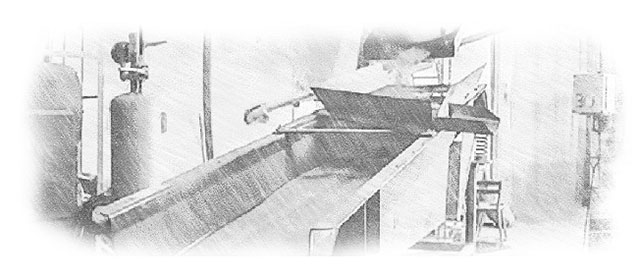

In 1898 Heinrich Heublein, the son of the former brewery owner Heublein, opened a sand pit at the northern slopes of the common hill in Weißenbrunn. By means of iron carts the sand was transported approx. 60 m on rails to the grit washer which had been built in the local meadow. Here the sand was washed, sorted and dried. At first building sand was extracted this way, futhermore sands rich in feldspar and white-burning sands were sold as sands for porcelain production.
Heinrich Heublein had found out that these sands were very suitable for the production of porcelain, provided feldspar and kaolin were added to them. Around the turn of the century (1900) he employed about 25 day labourers. They were paid 12 deutschmarks per week for a 10-hour workday. The company increased every year, and in 1915 the production of porcelain bodies was established.
When the local railway Neuses-Weißenbrunn was built and set into operation, an industrial railway was built from the railway station of Weißenbrunn to the factory, so the products fabricated there could be transported at a better price.
When the company was taken over by Tettau and therefore merged in the public company, the facilities were built and equipped according to the latest standards. The pit are at the community hill had meanwhile (1934) expanded to approx. 200 hectares.
At the beginning of World War II a modern grinding and processing plant was built which was able to supply a lot of porcelain factories.
At first, up to 80 persons worked there. A few months after the war, the company had reached its normal operating capacity again. The sand was extracted mechanically by means of compressed air and pneumatic spades, then it was broken up by crushers.
From 1947 to 1950 sales were excellent, so production was done in three shifts. In 1949 several new halls were built. A diesel engine transported the sand was transported on the railway to the grit washer. Next to the existing railway a loading bank was erected.
The porcelain bodies and glazes were shipped either being compacted and moist or in sacks after having been dried and pulverized. Quarzsandwerke Weißenbrunn was the most important independent manufacturer of porcelain bodies far and wide. In 1953 almost 135 workers and employees worked at the factory. In 1966/67, a new, generously designed processing plant especially for special ceramic bodies was built next to the old facilities.
In this part of the factory, ready-made bodies for porcelain production (china and technical products), steatit, cordierit and aluminium oxide can be produced simultaneously.
There is also a large store for the about 100 raw materials necessary for that as well as big, heavy duty wet-grinding mills, large homogenizing and mixing aggregates and numerous grading and cleaning devices. The core piece of the company are three so-called spray driers which produce a fine-grained granulate from the wet-ground and mixed raw materials.
The clients can optionally extrude this granulate into plates (chinaware) or complicated technical items before it will be baked at temperatures of 1250° C to 1400 ° C, thus becoming the finished ceramic product.
Nowadays these spray driers, which in 1966 were prototypes, still are the most efficient and economic plants for making such products. In 1999/2000 another spray drier was added, and the factory was modified accordingly.
In spite of the economic crisis in the field of tableware porcelain, the company has been increasing steadily over the last 10 years, so a new plant was required for the many various products on offer. From 2004 to 2007 the factory was extended by a complete processing plant, comprising separate processing facilities plus another spray drier.
At present the factory in Weißenbrunn has a staff of approx. 70 persons and produces more than 25,000 tons of spray granulate per year. About 25 % of the bodies produced are exported to numerous countries in Europe and worldwide. Raw materials imported from all over the world are processed and refined in Weißenbrunn. So the company ranks among the market leaders in the field of technical spray granulates and is most optimistic about the future.